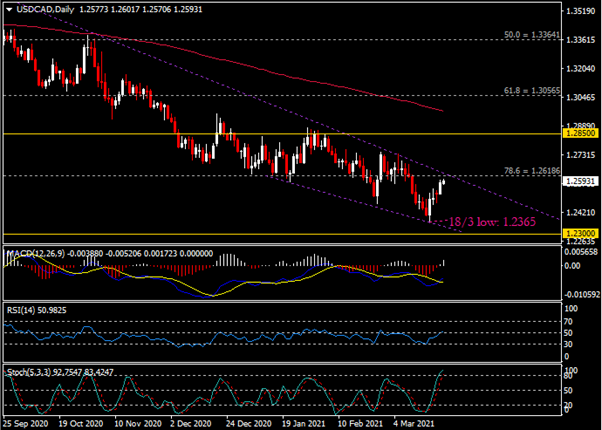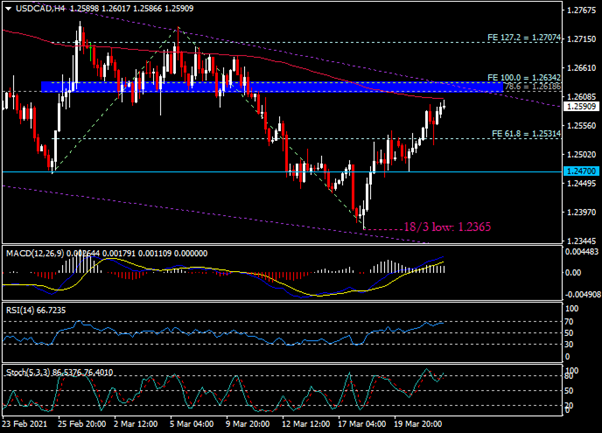The recent fundamental news is not beneficial for the oil market, and may also have an impact on the Canadian economy, which is one of the major crude oil exporters to the US. The Canadian Dollar has performed mixed against a basket of major currencies this week. Among them, the US Dollar, Yen, Euro, and Swiss Franc performed better than the so called commodity currencies such as Canadian Dollar, the New Zealand Dollar, Australian Dollar, and British Pound.
Overnight, US crude oil fell strongly by approximately 7% approaching a 6-week low at $57.34 per barrel. The main factor that contributed to the shift in sentiment in the oil market is the recent announcement by many European countries that they will tighten/extend restrictions to curb the continued rebound of virus infections. Affected by the inability of pharmaceutical companies to deliver sufficient batches of vaccines in accordance with the agreement, the current vaccination rate in most European countries is below 20%. Among them, Bulgaria is the country with the lowest vaccination rate in the Eurozone, with only 5.31% recorded. The latest data shows that the gap between the cumulative number of virus infections and deaths in Europe and the United States has widened substantially. Previously, when the vaccine had not been successfully developed and launched on the market, the number of virus infection cases and deaths in the United States basically occupied the top spot in the world. However, since Biden won the election to become the new President of the United States and quickly announced a mass vaccination for the people, the current situation has greatly improved. In contrast, the road to vaccination in Europe is extremely bumpy. The economic blockade in Europe will greatly reduce its import demand for the oil market.
On the other hand, India, as the world’s third largest oil consumer, is also facing a surge in infections. The sharp drop in local demand has affected the oil market. In Southeast Asia, oil demand has also entered a period of plateau, so the effect of boosting oil prices is limited. In addition, there is news that Saudi Aramco intends to increase oil production in the next few years, which undoubtedly provides favorable support for the bears. Earlier, the US API crude oil inventories increased by 2.927 million barrels in the week ending March 19, which exceeded market expectations by a decrease of 908,000 barrels and a decrease of 1.047 million barrels from the previous value, which was negative for the oil market. Next week, market investors will also focus on the OPEC+ conference, where it is expected that the organization will make a final decision on the output in May.
It is worth noting that Toni Gravelle, deputy governor of the Bank of Canada, said earlier that the central bank may gradually reduce the scale of its quantitative easing in the short term as the environment improves. In any case, he did not provide a specific time for the implementation of the QE reduction. Gravelle also said that all central bank decisions will depend on economic development and performance, and policy adjustments will promote a more resilient rebound in the economy.
The recent rise in the US Dollar has also put pressure on the Canadian Dollar. As of yesterday’s close, the US Dollar Index rebounded strongly by more than 0.6% to 92.35. It is worth noting that the US index and US bond yields have diverged. As of yesterday’s close, the 10-year Treasury bond yield fell back to 1.62%, a decline of about 0.1% from the recent high. The performance of Treasury bond yields reflects the demand for holding safe-haven assets including Treasury bonds.
The daily chart shows that after the US Dollar against the Canadian Dollar rebounded from the low of 1.2365 seen on March 18, it has now recorded a gain of nearly 230 points and is approaching its long-term trend line resistance at 1.2620 (the 78.6% Fibonacci retracement level from September 2017 to 2020 rally). A candle closing above this level will signify the first successful bullish breakout for the currency pair. In terms of indicators, MACD presents a golden cross, the Relative Strength Index (RSI) tends to the 50 level, and the Stochastics is in the overbought area but continues to rise.
The 4-hour chart shows that the currency has stabilized and rebounded against the 61.8 expansion level of 1.2530, currently testing the key resistance areas – the 200-day simple moving average and the 1.2620 to 1.2635 level. If the breakthrough is successful, the upper resistance will focus on 1.2710 (127.2% Fibonacci extension level and short-term resistance), 1.2800 (161.8% Fibonacci extension level and also short-term resistance) and 1.2850 (long-term resistance).
However, the failure of the exchange rate breakout may provide a reason for the bears to enter the market. Below support focuses on 1.2530 (61.8% Fibonacci extension level), 1.2470 and 1.2365, the low seen on March 18.
Click here to access our Economic Calendar
Larince Zhang
Market Analyst – HF Educational Office – Malaysia
Disclaimer: This material is provided as a general marketing communication for information purposes only and does not constitute an independent investment research. Nothing in this communication contains, or should be considered as containing, an investment advice or an investment recommendation or a solicitation for the purpose of buying or selling of any financial instrument. All information provided is gathered from reputable sources and any information containing an indication of past performance is not a guarantee or reliable indicator of future performance. Users acknowledge that any investment in Leveraged Products is characterized by a certain degree of uncertainty and that any investment of this nature involves a high level of risk for which the users are solely responsible and liable. We assume no liability for any loss arising from any investment made based on the information provided in this communication. This communication must not be reproduced or further distributed without our prior written permission.





















